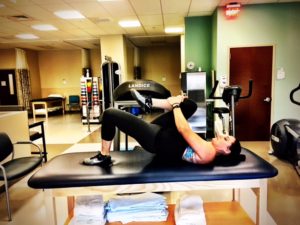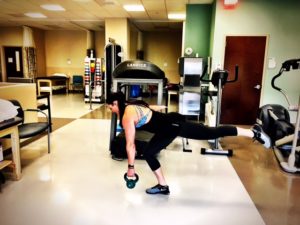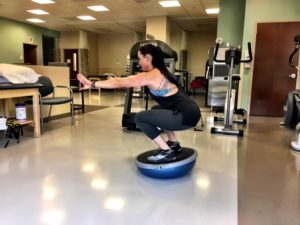By Courtney Budd, PT, CSCS, PES
Director, Physical Therapy, Cooper Bone and Joint Institute at Inspira Woodbury
The temperature is dropping and soon ski season will be here. Are you ready to hit the slopes? Whether you like to stick to the groomers, moguls, or search out fresh “pow pow” in the back-country, setting yourself up for success with proper conditioning and gear is crucial for a successful and injury free ski season.
Skiing is a high-risk sport specifically for knee injuries. While skiing and controlling deceleration the knee is positioned in postures that put the ACL and MCL at high risk. Proper form and strength are imperative to prevent injury. Many injuries occur at the end of the day when skiers are fatigued. Before you take “one more run” at the end of the day, take a minute to assess your fatigue level.
Proper form is imperative. Take lessons from a professional instructor to learn proper technique. Leaning back or sitting back on your skis puts your knees at high risk. Always lean slightly forward, keeping your weight distributed on the front half of your feet.
Equipment Recommendations
Make sure your skis and bindings are purchased and serviced at a licensed ski shop, and that your boots and skis are fitted by a professional. The DIN setting on your binding is very important. For your safety, this setting needs to be set correctly so that your boot releases from the ski appropriately. Wear a proper fitting helmet with compatible goggles and use the chin strap.
Conditioning
Being in good physical condition will help you avoid injury and increase your enjoyment. You should plan for at least six weeks of ski-specific conditioning to train appropriately to prepare for skiing. Even if you are working out daily, skiing is a very demanding sport and requires specific training. Baseline cardiovascular fitness and flexibility are very important. Skiing requires control of compound movement patterns. By incorporating core work with leg specific training you will improve your dynamic stability while skiing. The focus of training must include eccentric loading (deceleration), single leg power, and single leg endurance. It is recommended to complete these exercises at least three- to four-times a week for maximal benefit.
Five Ski-Specific Exercises for Injury Prevention
 1. Single Leg Squat: The stronger you can be with your single leg squat, the more control you will have during skiing. By building up gluteal/hip/knee control with this maneuver there will be less stress on your knees while skiing. Four sets of four on each side.
1. Single Leg Squat: The stronger you can be with your single leg squat, the more control you will have during skiing. By building up gluteal/hip/knee control with this maneuver there will be less stress on your knees while skiing. Four sets of four on each side.
 2. Single Leg Bridge: This exercise incorporates core and single leg control which is important for dynamic control during skiing. Hold 10 seconds. Repeat four sets of four on each side.
2. Single Leg Bridge: This exercise incorporates core and single leg control which is important for dynamic control during skiing. Hold 10 seconds. Repeat four sets of four on each side.
 3. Plank: This popular exercise is an excellent way to achieve core stability. You can also increase the challenge by alternating leg lifts in this position. Hold one minute. Repeat three times.
3. Plank: This popular exercise is an excellent way to achieve core stability. You can also increase the challenge by alternating leg lifts in this position. Hold one minute. Repeat three times.
 4. Romanian Deadlift (RDL): This exercise focuses on hamstring control and single leg strength which is important for ACL protection. Four sets of eight repetitions.
4. Romanian Deadlift (RDL): This exercise focuses on hamstring control and single leg strength which is important for ACL protection. Four sets of eight repetitions.
 5. BOSU® Squats: Focusing on squatting exercises with a balance or proprioceptive challenge is important to help train your body to adapt to unexpected conditions or terrain. Hold 10 seconds. Repeat 10 times.
5. BOSU® Squats: Focusing on squatting exercises with a balance or proprioceptive challenge is important to help train your body to adapt to unexpected conditions or terrain. Hold 10 seconds. Repeat 10 times.
Best wishes for a safe and enjoyable ski season!
If you would like a sport-specific fitness evaluation which includes a personalized, progressive fitness program for skiing, please call our Glassboro office at 856.595.9120.
